
Nick admits that being a dry fly purist has its challenges, but they’re not insurmountable.
The number of methods and styles covered under the definition of ‘flyfishing’ is large, and seemingly ever-growing. Most species of fish on the planet seems to have become a fly target. Even within the scope of trout fishing, variations such as Euro nymphing, micro Spey, and more, keep adding to the list.
For me however, as the seasons go by, it’s getting more and more simple: I love fishing for trout with a single dry fly; so much so, I’ve almost become a purist. This isn’t purism in a judgemental sense; certainly not in regard to difficulty, ethics or it being the highest form of the art. I’ve fished enough with nymphs and other techniques to know that all methods have their challenges and rewards.
However, several practical elements combine to give me more satisfaction from dry fly than any other method. Firstly, there’s the visual aspect: the memorable spectacle of the trout taking the fly. For me, this component extends to watching someone else (as long as they can fish competently)! This year I had the pleasure of sharing the final day of the Tasmanian season with Peter and Lachie Hayes, and David Hemmings. Rather than split up, all four of us fished together, in turn, with the other three watching. I had as much fun (possibly more!) watching and learning from these highly skilled anglers and casters, as I did when my turn to fish came up. With the fly being visible to all of us, we all felt ‘in the game’ regardless of who was fishing. The fact we could actually see the fly was key to this. I’ve watched other people fish with other methods, and I lose interest very quickly.

On a technical level, the visibility of a floating fly gives constant feedback on how the fly is drifting, which determines the type of cast and mend required for a drag-free drift. It can be very satisfying to fish a stretch of water well even when the fishing is slow. If you manage perfect drifts in tricky currents, that can be rewarding in itself.
Related to this is the satisfaction of precision casting a dry fly. Achieving pinpoint accuracy with a floating fly is just so much fun!
Another plus with the dry fly, is the timing of the strike. How long to wait? And will the strike connect or not? Time seems to stand still between the rise and the strike, and the build of anticipation is like some sort of drug.
And finally, I do have a philosophical thought on the magic of the dry fly. Fish live under the water, and we live out of it. It’s a cool feeling to meet them at the surface of the water, on the boundary of our two worlds.

After all that, to each their own, and I’m not trying to convince people that they should fish the dry fly more. But I do often hear anglers say they would fish the dry more, if only it was more effective, or the conditions allowed. Well, for over forty years, I’ve managed my whole fishing season – from opening to closing weekend – based almost exclusively around the dry fly. So perhaps I can provide some tips to give people confidence to spend more time fishing a dry if they want to.
Tiemco Long Drift Leader is available at The Flyfisher
Lesson 1 - Commit!
As with success in anything, commitment is an essential first step. If, after drifting a few nice-looking runs nothing takes the dry, it can be tempting to change to a wet. However, if you make the change, your attention necessarily becomes focused on what you are doing, and you can miss dry fly chances without even knowing.
This lesson was demonstrated when I visited Pennsylvania in 2019 to fish with my bamboo rodmaking mentor, Jeff Wagner. We are both dry fly addicts and we were there to fish the legendary mayfly hatches, including green drakes, sulphurs, blue-winged olives, grey foxes and more. We were committed to the dry fly and that was that.
While the hatches were happening, a superficial scan across the water didn’t show any fish rising. The local guides, who were friends of Jeff’s, fished exclusively with nymphs. Often, when we caught up with them at the end of the day, they hadn't seen a single rise. When we came across each other on the river, Jeff and I would usually be sitting on the bank, or standing in the water, seemingly staring into space. Meanwhile, they would be with clients, who were casting and casting and casting and casting, with grim determination. One of the guides eventually said to us, “What you guys do isn’t fishing, it’s sitting on the bank waiting to die.” We all had a laugh about that.

But here’s the thing. We were fishing. While they were casting, we were looking for fish. And we saw them. Not rising like sitting ducks in the middle of the river, but hard in on the edges, under bankside cover, sipping so quietly, that if you weren’t truly committed, you would miss them. And we had challenging, but glorious fishing every day. All on the dry fly.
Lesson 2 – Improve your skills
A consequence of lesson 1 is that if your chances are limited and/ or challenging, you need the skills to make the most of them when they come along. This takes practice. The better you are at casting, mending and other line management; choosing the right fly and other aspects of streamcraft, the more fish you will catch. Peter Hayes’ ‘Being Better’ columns are invaluable for addressing these areas.
One overlooked skill is seeing fish (if you’ll pardon the pun). The only way to learn this is to take the time to look. I can’t stress enough how beneficial it can be to spend at least a few minutes to look at the water before charging in and casting all over the place. Looking includes both trying to see visible fish or rises, and analysing the water more generally for the best feeding lies. Too many times, I’ve seen people wade straight in – right on top of where they should be casting!

Over time, your ability to read water and where to look more closely for tell-tale signs of fish, will improve. The better trout will usually hide in places that make them hard to see as well as hard to catch, so you’ll start to scan open water broadly, and then look longer and harder in the sneaky corners.
If you still can’t see any trout, the dry fly can still be effective for ‘fishing ‘em up’ to quote David Scholes. That is, fishing your way the most likely water. Knowing where to ‘blind’ cast is a skill in itself, and only comes with experience. Feeding lies – including those which favour surface feeding – change with the season and conditions (more on these later), but over time your knowledge bank will grow, so you can fish the best water efficiently and then move on.
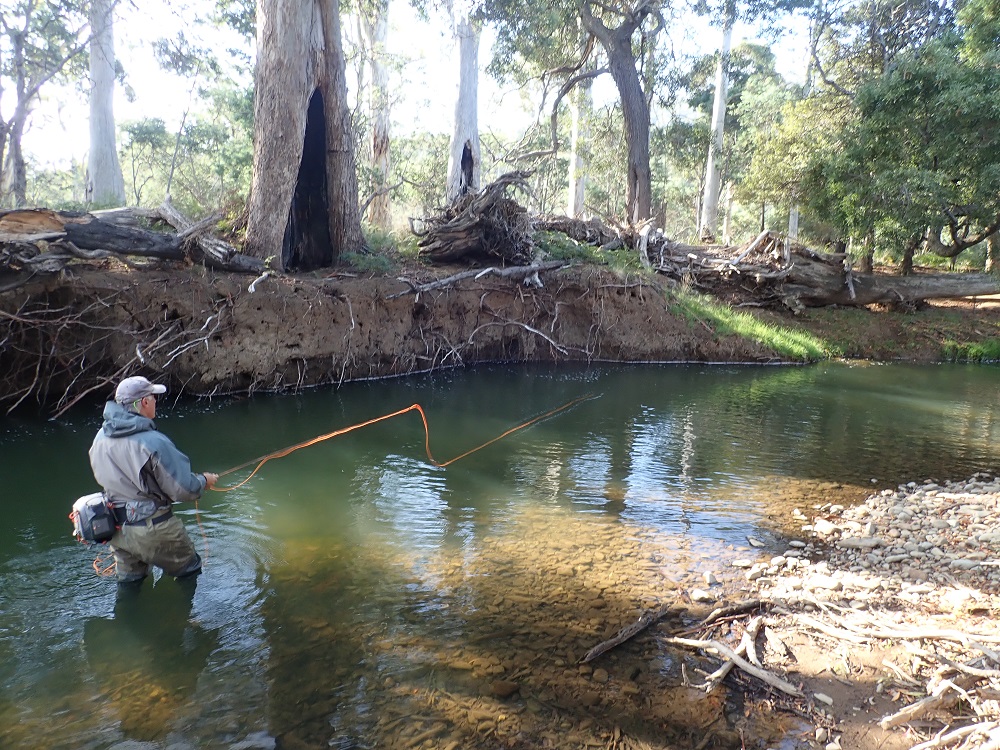
Once you have decided where you should cast, other skills like casting accuracy, presentation, mending, and line management come into play. All these skills can be developed to some degree even if you live a long way from your fishing. At the very least, there’s really no excuse for not working on improving your casting.
The importance of skill enhancement was hammered home at our recent ‘Cressy Cane’ gathering. Japanese anglers Tomonori ‘Bill’ Higashi and Naoto Shibuya attended as presenters. Bill is a highly capable angler and FFI Master Casting Instructor who fishes around the world for everything from billfish (hence his nickname) to tarpon, taimen, steelhead, Atlantic salmon and of course trout. He’s also worked as interpreter and translator for flyfishing legends such as Mel Krieger, Rene Harrop, John Gierach and more. Bill has also worked on fly rod and other tackle development. So, to have him visit and demonstrate his casting and fishing knowledge was wonderful.
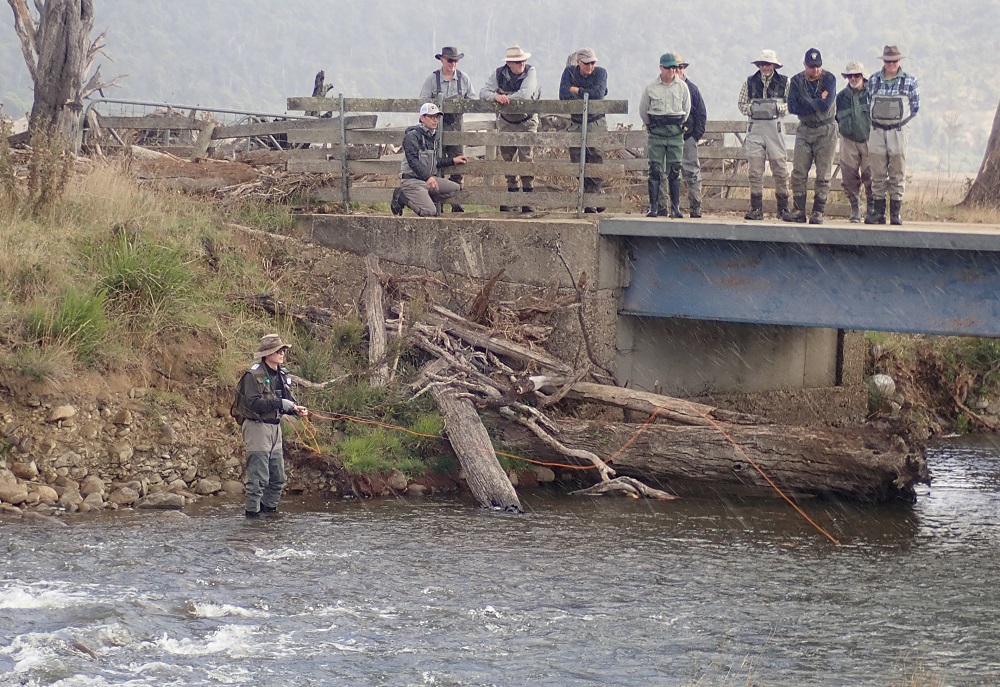
From a technical dry fly point of view however, Naoto Shibuya took our inspiration to another level again. Naoto has developed the Japanese long drift leader (LDL) dry fly fishing to an extraordinarily level. It was exciting to see how much room for improvement my own fishing has.
Lesson 3 – Location and Timing
Choosing a location for the dry fly is important. Of course, some fisheries are better suited than others to the dry fly, based on the food available and how much of it appears on the surface of the water. Hatching/emerging aquatic insects and falling/spent insects (including terrestrials) both contribute.
However, a location can’t be chosen on its own without considering timing and the water conditions. There are three elements to timing: time of season, the weather conditions, and the time of day. Again, David Scholes writes about this in ‘The Way of an Angler’, in the chapter ‘The Problems of a Purist’ (hence the title of this article)! What a fine and relevant book it remains to this day.
Hatches and falls occur at different times of the season. As David noted, the hardest time for the dry fly die-hard is early in the season, when the water levels are often high and cold. At such times though, small streams are often more dry fly-friendly than larger rivers. Some small feeder streams can even be at their best early in the season, when they temporarily hold trout from the larger rivers they feed. Altitude can also have an effect, with lower altitude streams tending to be warmer and more productive than high country waters for the first couple of months of the season.
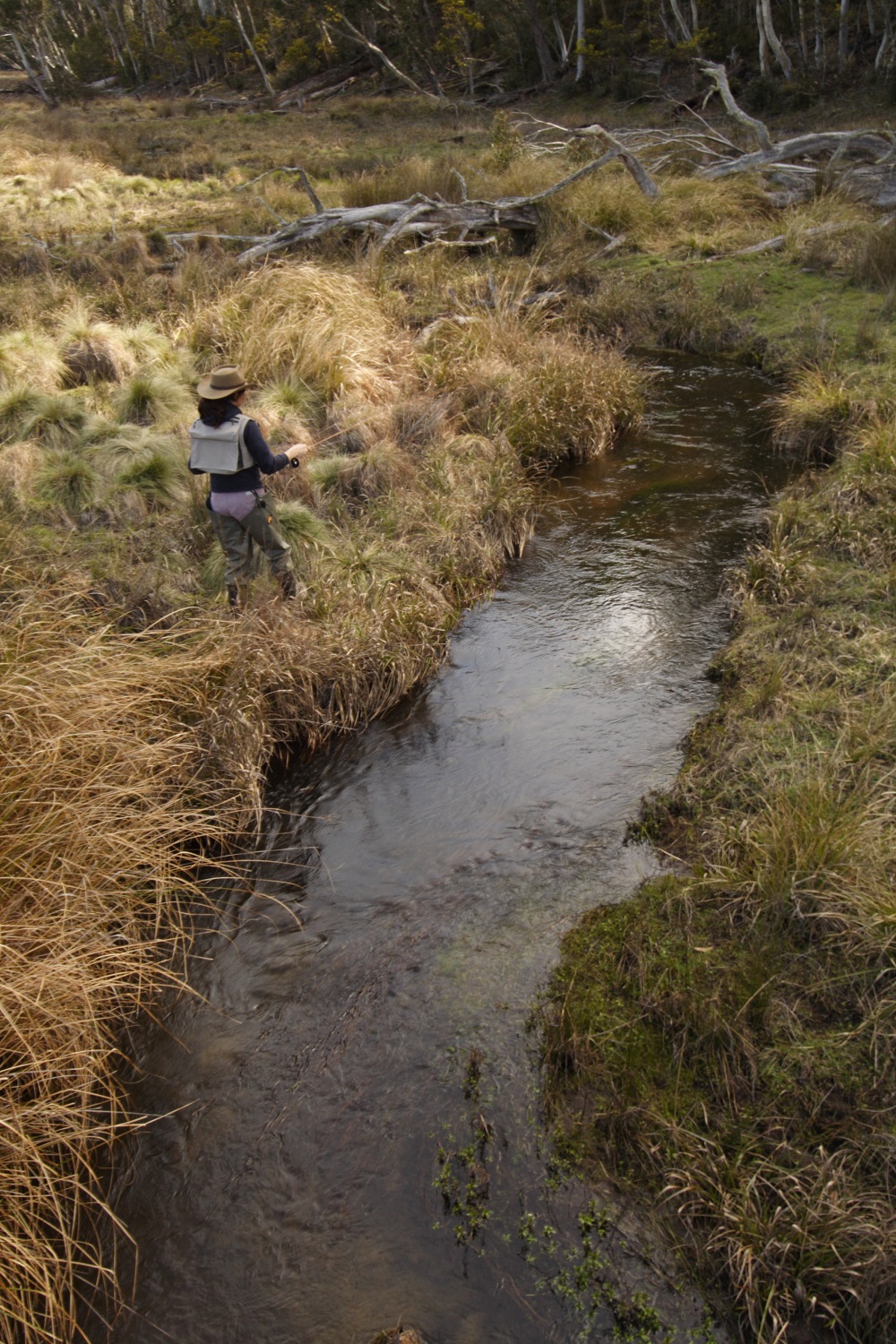
Even when the time of season is ‘right’, bad weather can intervene through cold conditions, which shut down insect activity; or rain leading to high and coloured water. Luckily, when it comes to short-term weather intervening, we have much better access to weather forecasts these days, so picking your days can be an option if you live close enough to your fishing. And even if the weather turns unexpectedly for the worse, commitment, and having your skills as sharp as they can be, should still deliver a fish or two. The sense of reward for persevering with the dry can be very satisfying.
As mentioned in lesson 2, on any given stream, surface feeding lies will change with the season and conditions. For example, summer feeding lies in deep water and stronger flows, will seldom bring success during the colder months and higher water. Softer flows off the main current, back eddies and shallower water in general are the places to focus on when pushing dry fly fishing to the limit.
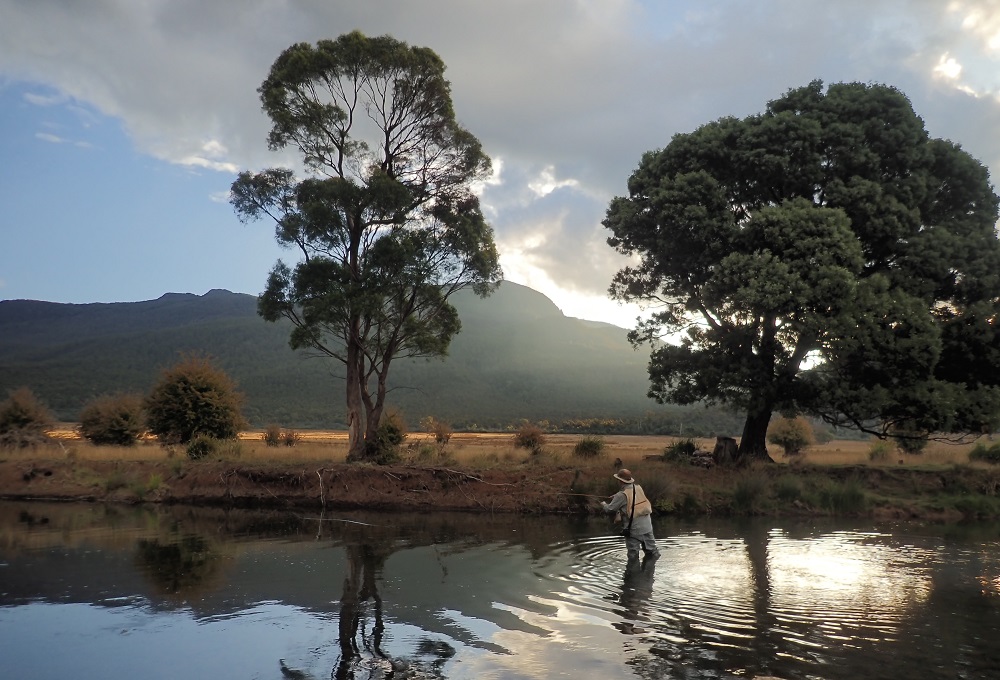
The final factor is time of day. During early season and other cold or high water conditions, the warmest part of the day will usually provide the best chance of bringing some fish up to the dry. The good news is that early starts are seldom required in these situations, so you can sleep in! It's worth noting that there can be some lag between the day warming up and the fish starting to respond to the dry, so don't give up if the fish don't switch on straight away. Persevering can lead to making the most of the window of opportunity when it arrives. Often, this successful window of time can be mistakenly attributed to the location. I can recall many times when the fishing suddenly starts to improve along the river, or changing location to another nearby stream brings instant results. Was greater success due to the where or the when? Sometimes this question is answered when walking back to the car, seeing feeding trout in places you’d whipped to a froth earlier in the day without a hint of success.
Lesson 4 – Flies ain’t flies
I love matching the hatch wherever possible, as for me it gives a deeper meaning to my angling experience and stronger connection with the trout and their environment. In these situations, the choice of fly is relatively straightforward – try and use something as close as possible to what the fish are eating! But when no food source is dominant on the water, or you can’t see anything at all on the surface or in the air, you have to decide what to tie on. There are many well-known searching patterns, and each angler will have their favourites. It is often a balance between using something large enough to get the trout’s attention, while not using something so big that it falls outside their recognition of food. Suffice to say, it’s worth changing both the pattern and size if what you are using isn’t working.
Similar to the location dilemma, sometimes a fly change can occur at the start of the feeding window, awarding a ‘false positive’ to the fly change. One way around this is to fish with a partner, and have each of you use a quite different dry. I had this experience recently with Lachie Hayes on a Tasmanian stream. Fish were rising here and there but not consistently, so we fished blind in between casting to fish we could locate. Just for fun, Lachie started tying on bigger and bigger funky foam hoppers… and more and more fish came to his fly, especially the larger fish in the river.
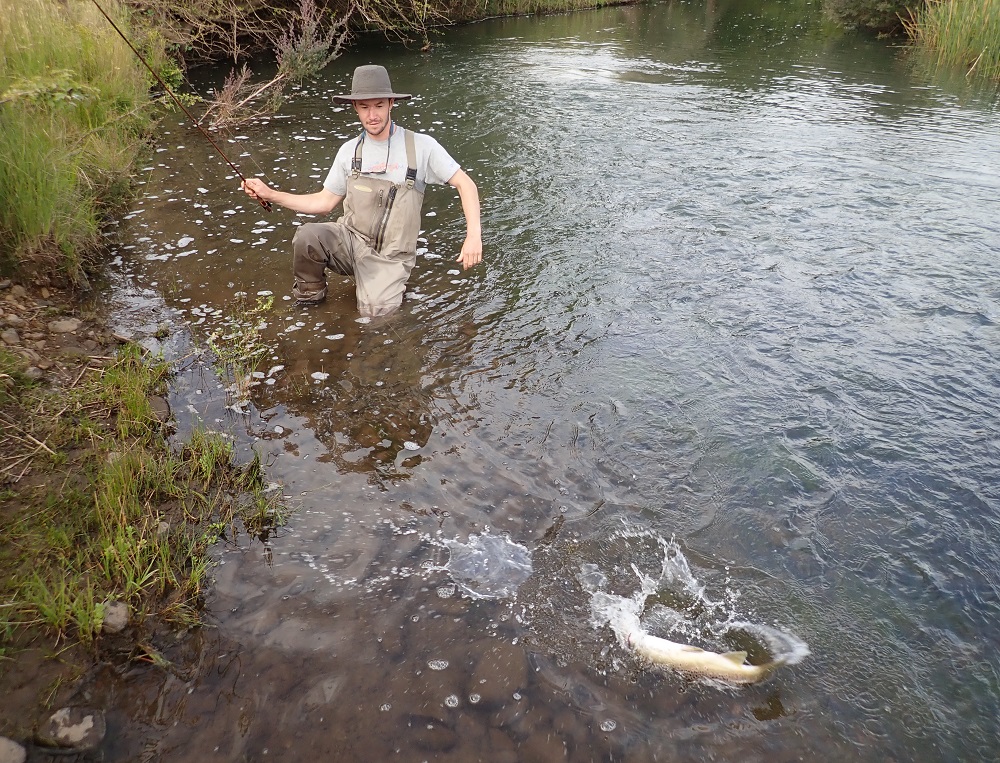
Weeks later, on the last day of the season, we fished the same stream, and had to change to a size 20 midge to fool a quiet sipper along the bank edge when even a size 16 parachute was treated with disdain.
Try the dry side
Such is the variety with dry fly fishing, and that’s what can make it among the most enjoyable ways to fish. Hopefully, the pointers above will encourage at least some flyfishers to join me on the dry side – if not all the time, then at least more often.











